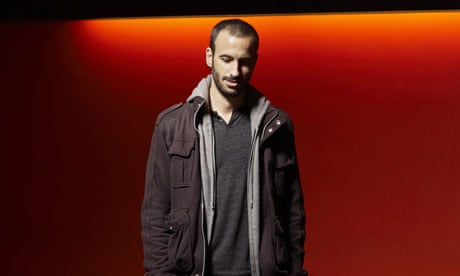From the outside, the contemporary dance world can look uninviting. A members-only club dedicated to über-seriousness and having no fun. And, too often, as you take your place for the latest slice of po-faced conceptualism, that's what it looks like from the inside too. So when, shortly after the millennium, a whip-smart young Israeli choreographer started kicking down the walls enclosing the art form, there were cheers from insiders and outsiders alike.
His name was Hofesh Shechter, and he had trained as a dancer in Jerusalem and as a percussionist in Tel Aviv and Paris. He had also done his statutory two years of national service, and when he arrived in Britain in 2002, he was one of the few dance practitioners who could strip down and reassemble an Uzi machine-pistol blindfolded. He was angry, he was darkly handsome, and he had a lot to tell the world – not least that much contemporary dance was "boring". Some of his peers would find him arrogant; most stood back wide-eyed, watching his rocketing ascent.
To begin with, Shechter kept a comparatively low profile, performing as a dancer with his London-based compatriot, the choreographer Jasmin Vardimon. In 2003, he created Fragments, the first of a triptych of inventive, award-winning works set to his own compositions, which propelled him to the forefront of new British choreography. But it was the furiously charged Uprising (2006) that showed what he could really do. Drawing on his national service experiences, the piece showed a seven-strong squad of men hurling themselves through a series of militaristic rituals to a driving score. The work reflected the tension of life in Israel, where, Shechter says, "there's a combative feeling in the air. It melts into everything. It's like an energy you're living inside."
If his work was articulate, the choreographer himself was laconic. "I'm not the chatty type," he explains wryly. "So if an immediate discussion such as 'what's for dinner?' is off the table then I'm a bit stuck." He has always been something of a loner, and because he works so much of the time finds it "hard to maintain a linear relationship with people". He has a long-term girlfriend of whose privacy he is highly protective, and whom he needs "slightly more than oxygen", but otherwise his closest relationships are with the members of his Brighton-based Hofesh Shechter Company. "The dancers and I are friends, experimenting together. People are kind to each other. And I'm there, sweating harder than any of them." Outside the studio, his greatest passion is tennis, a game in which he finds "an amazing combination of instinct, calculation, tactics and mental resilience".
In 2007, after five hard months in the studio, Shechter's In Your Rooms broke over the UK dance scene like a tidal wave. The piece was unusual in that it was a joint commission by three London venues (the Place, Southbank Centre and Sadler's Wells), hence the title. There was the score, a thundering percussive assault, and there was the noir-ish choreography, with phalanxes of men and women match-flaring into view, bristling with existential fury, and fading back into darkness. Scene succeeded scene, each phosphorescent tableau overlaying the last, and the result was at once deathly and exultant. This was contemporary dance as rock concert, a spectacle from which you reeled into the night with your brain flayed and your ears singing, and when Shechter repeated the piece at the Roundhouse in Camden, north London two years later before a jam-packed, beer-chugging audience, the barriers seemed to have dissolved altogether.
Five years on, Shechter is an established luminary of the dance world, and his company, for whom he has created two further works, The Art of Not Looking Back and Political Mother, has become a significant presence on the international dance touring circuit. At home, he has won a critics' circle award (for best choreography, 2008), been nominated for two South Bank Show awards, choreographed plays for the Royal Court and the National Theatre, and created an opening sequence for the Channel 4 series Skins.
Life in Britain, he says, is easier than in Israel where "everything's a negotiation". Here, he says, you're given a choice. You don't have to fight your corner every minute of every day. "You can engage, or you can walk away." Politicians, however, are much the same the world over. "I feel sorry for them. Politics has arrived at a weird place, an inhuman place, where the natural instincts are not trusted any more, and some form of highly calculated language rules. In fact, the more complicated the words are, the more stupid the idea that they're hiding." Conversations with Shechter often return to the dichotomy between emotion and the "mouse maze" of language. Politicians and others, he says, "are stuck in a horrible world where being emotional in any way counts as being unbalanced, and unable to think clearly. For me, emotions are thought."
As well as being formed "mentally, physically and emotionally" by the process of growing up in Israel, Shechter saw his parents "getting divorced, remarrying someone else, divorcing, remarrying someone else, and so on…" The strain of this "family complexity" is evident in The Art of Not Looking Back, created for the six female dancers of his company. "My mother left me when I was two years old," Shechter announces on the soundtrack, as the performers writhe and clutch themselves. "It's like having a bucket with a hole. No matter what you pour in, it's always empty." An unflinching spectator of his own pain, Shechter uses dance to twist it into something feral and even beautiful. Typically, however, he denies us a redemptive ending. "I don't forgive you," he concludes flatly, as the lights fade to blackout.
His latest venture is Survivor, a collaboration with the sculptor Antony Gormley. Here, for the first time, Shechter's musical composition will take precedence over his choreography. The project, which will see five "living sculptures", a 30-strong band and an army of a hundred drummers sharing the Barbican stage, is colossal in scale, and when I meet Shechter at Gormley's north London studio, he tells me that the piece's themes are those which have long preoccupied him. "Man against the world, that's the story. From the moment you're born, you're asking yourself: what's my place in this? I look at our helplessness before nature, before the cosmos…"
Shechter smiles. He seems exasperated by human nature, not least his own, speaking of "the fight between the thinking mind and the bubbling beneath; the way we're ruled by needs and urges".
Shechter's work succeeds because it bypasses the cerebral, analytical place where most contemporary dance finds a lodging, and strikes directly at our buried fears and longings. What he shows us is the void, against which human activity appears by turns ludicrous, frantic and sad. Although his choreography is electrifying in its beauty and originality of craft, creation does not come easily to him. "I walk into the rehearsal studio and I think everything I've done to date is shit. There are cycles of hope and loss of hope. Cycles of belief and loss of belief. There's despair."
But in working with Gormley, whom he met when the sculptor came to the Roundhouse show in 2009, Shechter seems to have found a kind of peace. To begin with, he was apprehensive. "I was worried we'd get into arguments, because we're in a different place regarding anger and acceptance. But actually, I feel free. We've been dreaming together, and I've discovered that Antony also has a place with anger in it." The sculptor's work, he says, operates silently. "It's about finding a place for a single body. A body in front of the world, at once inside and outside. There's a kind of helplessness in that. A sense of 'that's the way it is', which is very beautiful and sad. It's a feeling of being overwhelmed. A feeling of instability. A sense that everything can be taken away."
Listening to his words, I have the impression that Gormley has brought Shechter in from the cold, quietly redirecting his attention from his own psychic pain to a contemplation of the sublime. In creating the score for Survivor, Shechter is negotiating territory in which dread cohabits with a consoling beauty. A 40-metre onstage screen will show footage of "the forces that surround us. Forces which bring great fear, and bring great hope… I'm discovering the pastoral; it's a powerful, ancient feeling." Whatever the outcome of this collaboration, Survivor will be nothing if not grand scale. At an early stage of the project, Gormley spoke of the adventure of working with "the emergent architecture of Hofesh's pulmonary music", which is perhaps another way of saying that it's going to be a very loud gig indeed.








Comments (…)
Sign in or create your Guardian account to join the discussion